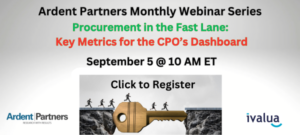A couple of months ago I wrote an article on innovation in the eSourcing space. New (relatively at least) solution providers like Globality, Pactum, Arkestro, and Fairmarkit have entered the market with innovative new capabilities, while more established ones, like Keelvar, Coupa, MarketDojo and others have extended and improved their offerings. As a result, there are more tools in the eSourcing toolbox than ever before. This has made it more complicated for those in the market for a new eSourcing solution because needs vary between organizations depending on spend profile and procurement’s operating model.
So, in today’s article, we’ll have a higher-level look at the different types of eSourcing tools and discuss the pros and cons of each.
“Traditional eSourcing”
For lack of a better term, the “old school” type of eSourcing focused on manual or semi-automated creations of online RFIs, RFPs, and RFQ traditional eSourcing. Even if UIs have improved over the years, these solutions typically require some training. This means that these solutions are best suited for organizations with a more centralized (or center-led/supported) approach, ideally with an eSourcing center of excellence where true experts get the most out of the solutions. Such solutions can handle most types of spend but will struggle with very large and complex RFXs (see sourcing optimization below). They also don’t typically support BoM structures, etc., that might be required for direct materials (see direct materials below).
All S2P and strategic sourcing suite providers offer traditional eSourcing (including eAuctions) — for more information, see Ardent Partners Strategic Sourcing Tech Advisor 2024.
eAuctions
eAuctions are typically part of traditional eSourcing solutions, but for clarity it has its own section here because its applicability is a little bit different. eAuctions work best for categories with clear and well-defined specifications (to ensure you compare apples to apples) and a competitive market. That said, there are auction types (reverse Dutch auctions for example) that work with fewer suppliers in less competitive markets, but these are less commonly used.
Sourcing Optimization
Sourcing optimization is the capability to find the optimal supplier award split among the different parts of the business. In other words, which part of your business you should award to which supplier. It allows you to create different scenarios by entering constraints into the solution (such as number of suppliers, amount of business per supplier, etc., either for the whole sourcing event, for a subset of items, or per individual item). Sourcing optimization also allows suppliers to provide discounts based on the total volume of business or if specific bundles of products are awarded. Non-price factors such as CO2 emissions or quality can also be factored into the scenarios.
Sourcing optimization is often associated with large complex spend categories, such as logistics, but should be used for any strategic spend category to ensure that different scenarios can be evaluated. Even sourcing events with a relatively low number of items becomes complex to evaluate when you take supplier discounts, CO2 emissions, and other constraints into account. For more information on Sourcing Optimization see this article.
Solution providers that support sourcing optimization include Archlet, Coupa, JAGGAER, and Keelvar.
Direct Materials
Direct materials sourcing solutions are typically a subset of traditional eSourcing solutions. But to better serve manufacturing organizations, they feature capabilities to support multi-level BoMs and should-cost modeling.
Solution providers that support direct material sourcing include Ivalua and JAGGAER among others.
Automated Sourcing
The latest wave of solution providers is focused on automating (parts of) the sourcing process using AI and RPA-like automation capabilities. Some are focused on automating the creation, management, and execution of the sourcing process, while others focus on automating the negotiation process. This category of solutions is sometimes referred to as autonomous sourcing, but I’m not a fan of that terminology since humans are still quite involved in the process to make decisions and approvals.
These solutions are typically very easy to use and guide the end users, thus limiting (or eliminating) the need for training. This makes the solutions useful for organizations with a decentralized operating model or where non-procurement end users do a significant amount of purchasing on their own. However, the solutions are maturing rapidly, and some can replace traditional eSourcing solutions — with the exception that they don’t support eAuctions. On the other hand, an automated supplier feedback process and multi-round RFQ capabilities can somewhat work as a substitute.
Solution providers that offer automated sourcing capabilities include Arkestro, Fairmarkit, Globality, Keelvar, and Pactum. But be aware: since this is a more emerging category of solutions, there are significant differences between these solutions and providers. Also, most of the S2P providers also offer some level of automation of the sourcing process.
Choose Wisely
What type of solutions (or capabilities) you need for your organization depends on your spend profile and your procurement operating model. The more complex types of spend and sourcing projects you have, the more likely you need a traditional eSourcing solution combined with sourcing optimization. And, if you are in manufacturing, direct sourcing capabilities as well. Sourcing automation can be useful, however. Sourcing automation allows procurement professionals to focus on higher value projects through less involvement in complex sourcing requests.
The only problem that remains is the decision of what solution or capability should be used when. But maybe that’s where we need orchestration functionality?
If you want to know more about the different solution providers and their capabilities, as well as what would be a good set up for your organization, Ardent Partners is here to help!


